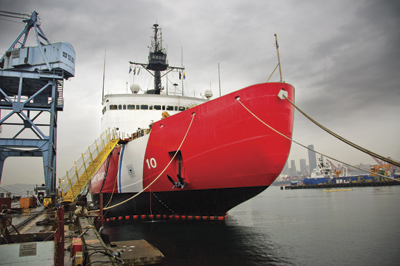The state of the United State's aging icebreaker fleet has been at a critical point for a decade, yet no action has been taken on a comprehensive plan to replace the vessels.
As of early December 2011, there was disagreement on Capitol Hill about what to do with the two current heavy polar icebreakers, Polar Star and Polar Sea, both of which are not operating.
At a time when Arctic ice is melting and several nations are attempting to stake a claim on Arctic resources, the United States does not have enough icebreakers to support its goals in the region — including maintaining a sovereign presence, carrying out ice operations, providing marine environment protection and demonstrating defense readiness.
Right now, the United States has only two polar icebreakers in operation. The 420-foot medium polar icebreaker Healy is operated by the U.S. Coast Guard and used mainly for scientific research in the Arctic. The 308-foot Nathaniel B. Palmer is operated by the National Science Foundation and supports Antarctic research. The 399-foot heavy polar icebreakers Polar Star and Polar Sea, both operated by the Coast Guard, are not in service. Each of the heavy icebreakers can break through ice up to 6 feet thick. Healy can break through ice up to 4.5 feet thick and Nathaniel B. Palmer can go through ice up to 3 feet thick.
Other Arctic nations have much larger polar icebreaker fleets: Russia has 25 ships; Finland, seven; Sweden, six; and Canada, six. And non-Arctic nations such as China, South Korea and Chile are moving to acquire polar ships.
"At a time of growing need, our polar icebreaking capabilities are steadily drifting into obsolescence," said Jeffrey M. Garrett, a Coast Guard rear admiral, now retired. Garrett spoke at a hearing on Coast Guard Arctic operations held Dec. 1 before the House Subcommittee on Coast Guard and Maritime Transportation.
The 35-year-old Polar Star is undergoing a $62.8 million refit at Vigor Shipyards in Seattle. Vigor expects the vessel to be ready by late 2012 or early 2013, according to John Lockwood, senior advisor for the shipyard. Lockwood is a retired Coast Guard rear admiral whose duties included responsibility for the polar icebreaker program.
Polar Star has not operated since 2006. The work by Vigor is expected to allow the icebreaker to operate for an additional seven to 10 years.
Polar Sea, commissioned in 1978, was overhauled in 2006 to extend its service life to 2014. However, this vessel has been out service since June 2010 because of engine problems.
As of December, there were several plans for the Coast Guard's two heavy polar icebreakers. The Coast Guard plans to decommission Polar Sea. However, the U.S. Senate Committee on Commerce, Science and Transportation passed a two-year Coast Guard budget in early November with an amendment that specifically prevents the service from decommissioning Polar Sea.
But on Nov. 15, the House of Representatives passed a three-year Coast Guard budget that calls for both Polar Sea and Polar Star to be decommissioned. Polar Star would end service three years after the bill is passed; the White House opposes this measure.
Republicans are apparently using this move as a means to force the White House and Coast Guard to be more specific about plans for the icebreaker fleet. U.S. Rep. Frank A. LoBiondo (R-N.J.) said there needs to be an honest national conversation about this issue.
"It is time that we stop wasting money on old, ineffective assets and focus instead on acquiring assets that will provide the capabilities we will need as we continue to increase our foothold in the Arctic," he said, in a Dec. 1 press release.
There are several different proposals to meet overall U.S. icebreaking needs. The cost to build a new polar icebreaker would be about $850 million, according to a Nov. 3 Congressional Research Service report on modernization of polar icebreakers, written by Ronald O'Rourke, specialist in naval affairs. It would likely take eight to 10 years to design and build one vessel.
An October 2011 report done for the Coast Guard by ABS Consulting of Houston recommended that the cheapest solution would be to build two new heavy icebreakers while maintaining Polar Sea and Polar Star, according to testimony at the Dec. 1 hearing by Stephen L. Caldwell. He is the director of the homeland security and justice section of the General Accountability Office. Garrett, who served as skipper of Polar Sea and Healy, supports this proposal.
Those at Vigor said Polar Sea could be reactivated at a modest cost. It would take two years and cost about $11 million to get Polar Sea operational again, according to Dave Whitcomb, CEO of Vigor Industrial, the parent of Vigor Shipyards. Lockwood said that both vessels had engine upgrades to make them more powerful. The engine modifications are blamed for the current problem with Polar Sea. The engine in Polar Star is being brought back to its original condition by Vigor.
Fixing the "main engine problem on the Polar Sea is the primary issue that needs to be corrected in order to bring the ship back operating," said Lockwood.
Work on Polar Sea would be done at Vigor Shipyards, since the company has a five-year contract to do repairs on both icebreakers.
In July, the Coast Guard presented its High Latitude Region Mission Analysis report to Congress. In order to meet the Coast Guard's statutory requirements in the Arctic and the Antarctic, it would need a minimum of three medium polar icebreakers and three heavy icebreakers at a cost of about $4.1 billion, the report said. It is unlikely that the Coast Guard could pay for new icebreakers through its budget, according to Caldwell. Other options could be to use money from the Department of Defense or the National Science Foundation.

